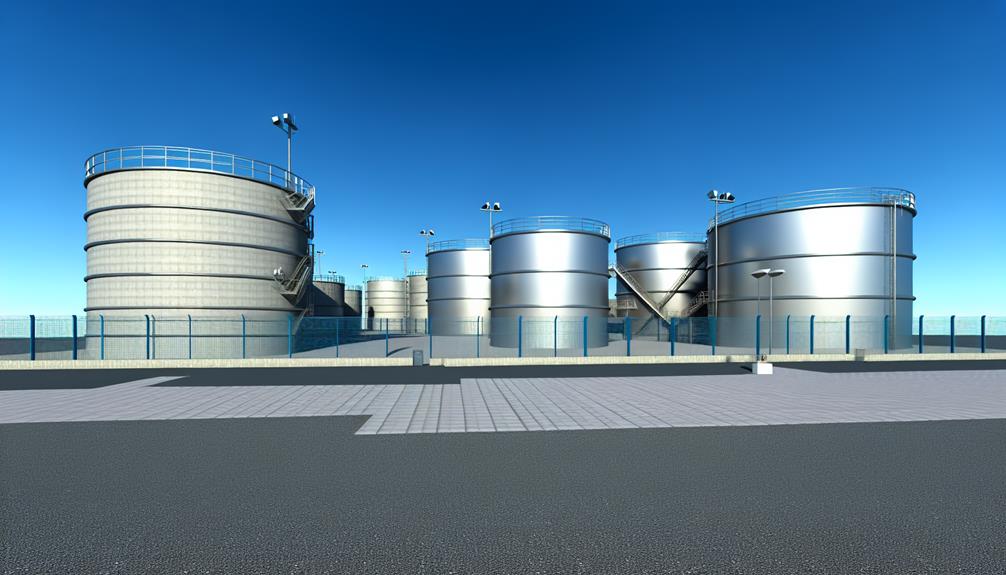You might not be aware that the design and material of storage tanks can significantly influence the safety and longevity of your stored resources. When you select the right materials and incorporate advanced monitoring technologies, you’re not just complying with safety standards; you’re also optimizing operational efficiency and resource management. Now, consider the risks associated with inadequate tank maintenance or the wrong choice of materials—could you be unknowingly compromising the safety of your environment and resources? Let’s explore how you can enhance your storage tank strategies to ensure maximum protection and efficiency.
Types of Storage Tanks
Storage tanks come in various types, each designed to meet specific industrial and commercial storage needs. You’ll find that tank materials primarily dictate their suitability for different substances and conditions. Common materials include steel, fiberglass, polyethylene, and concrete. Each material offers distinct advantages depending on your specific requirements. Steel tanks are highly durable and resistant to corrosion when coated or treated, making them suitable for a wide range of chemicals and petroleum products. Fiberglass tanks are lightweight and resistant to corrosion and chemical damage, ideal for storing corrosive substances.
When considering capacity, it’s vital to evaluate both your current and future needs. Tanks can range from a few hundred gallons to millions of gallons. Larger tanks are typically necessary for bulk storage of liquid products like oil or chemicals, while smaller tanks are often sufficient for more localized storage needs or less consumable volume. It’s not just about the total volume; the shape of the tank also influences its footprint and its compatibility with the available space. Cylindrical tanks, for example, are common and efficient in terms of pressure distribution and material use, while rectangular tanks might better fit certain spaces but require more careful design to withstand stresses.
Risks and Environmental Impact
Evaluating the risks and environmental impacts associated with different types of storage tanks is crucial for sustainable management practices. You need to focus on two key components: leak detection and contamination prevention.
Leak detection systems are essential in minimizing the risk of environmental harm. These systems alert you to the presence of leaks early, allowing for swift action to mitigate damage. It’s not just about spotting a drip; you’re monitoring for changes in pressure and volume that indicate a breach in tank integrity. This proactive approach is vital in preventing soil and water contamination.
Contamination prevention focuses on the design and maintenance strategies that keep hazardous materials contained. By choosing materials and designs that are resistant to the stored substances, you reduce the risk of the tank corroding or degrading over time. Additionally, proper installation and positioning can prevent overfilling and reduce stress on the tank structure.
Both elements are intertwined, creating a comprehensive strategy for environmental protection. Without rigorous leak detection, contamination prevention efforts can’t fully succeed, as unnoticed leaks can lead to significant environmental damage. Conversely, robust contamination prevention enhances the effectiveness of leak detection systems by ensuring that any potential leaks are contained swiftly and efficiently.
Regular Maintenance Practices
To ensure the longevity and safety of storage tanks, you must adhere to stringent regular maintenance practices. Crucially, maintaining a strict inspection schedule is paramount. You should have clearly defined timelines for routine checks, which not only comply with regulatory standards but also cater to the specific needs of the material stored. This proactive approach helps in identifying potential issues before they escalate into serious problems.
Focusing on seal integrity is equally essential. The seals in your tanks must be inspected for any signs of wear or damage during each review. If you detect any compromise in the seal, it’s imperative that you address it immediately to prevent leaks or contamination. Regularly testing seal strength and flexibility can provide insights into the lifespan of these components, enabling timely replacements.
Moreover, you need to document all findings meticulously. This record-keeping isn’t just a regulatory requirement; it also aids in analyzing the performance over time, helping to refine your maintenance strategy.
Technological Advancements
As the industry evolves, new technologies significantly enhance the efficiency and safety of storage tank operations. You’ll find that the integration of smart sensors and automation plays a pivotal role. These smart sensors provide real-time data on various parameters such as temperature, pressure, and volume levels within tanks. This information is critical, allowing for immediate adjustments and proactive maintenance, thereby reducing the risk of overfills or structural failures.
The automation integration further streamlines the process. Systems can now automatically adjust conditions to maintain optimal storage environments, considerably minimizing human error. This technology not only ensures the safety and integrity of the contents but also enhances operational efficiency by enabling faster, more accurate responses.
Moreover, these advancements support sustainability efforts. Automated systems optimize resource use and energy consumption, helping you meet environmental standards more effectively.
It’s essential to stay informed about these technological developments. Implementing them can significantly reduce operational risks and costs, while also boosting your compliance with increasingly stringent regulatory requirements. By adopting these cutting-edge tools, you’re not only safeguarding your resources but also positioning your operations at the forefront of industry standards.
Emergency Response Strategies
While technological advancements enhance safety and efficiency, it’s imperative that you also have robust emergency response strategies in place to effectively handle potential crises. As you manage storage tanks, understanding the specific risks associated with them is crucial. This knowledge forms the basis for developing and implementing effective response strategies.
First, engage in regular disaster simulations. These exercises simulate various scenarios, including leaks, spills, or fires related to storage tanks. By conducting these simulations, you’ll identify weaknesses in your current strategies and provide practical, hands-on experience to your response teams. It’s not just about having a plan on paper; it’s about ensuring that your team can act swiftly and effectively under pressure.
Additionally, comprehensive response training is essential. This training should cover both the theoretical aspects of potential disasters and practical, emergency-specific skills. Ensure that it’s an ongoing process, incorporating the latest safety protocols and technology updates. Each training session sharpens the responsiveness of your personnel, making them more prepared for actual emergencies.
Together, disaster simulations and thorough response training ensure that you’re not just reacting to emergencies, but proactively managing risks. This approach minimizes potential damage to your resources and ensures safety for all involved.




